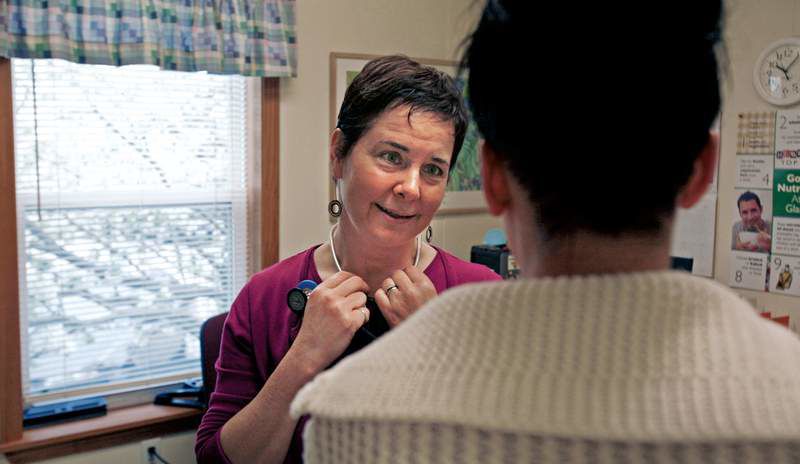Scientists try to stop schizophrenia in its tracks
Published 5:00 am Monday, July 27, 2009

- Ann Lovegren Conley, a family nurse practitioner at the University of Southern Maine, talks to a patient on the university’s campus in Portland, Maine. Conley has been trained to identify a troubled mental state usually found in teens and young adults that can lead to schizophrenia.
PORTLAND, Maine — She was sociable and happy in high school. But in college, that changed abruptly: Depressed and withdrawn, some days she couldn’t get out of bed.
And that wasn’t all.
“I had really odd thoughts,” recalled the woman, now 21, who asked that her name not be used. While walking across campus at the University of Southern Maine, “Sometimes I’d feel like people were just right behind me (who might) jump me or something.”
She knew it wasn’t true, but she couldn’t shake the feeling.
Sometimes, while driving, she saw imaginary, shadowy people on the sidewalk. And now and then, out of nowhere, there would be a woman’s voice in her ear during class.
When she visited the university health service and talked about feeling depressed, a nurse practitioner saw another problem: a possible case of schizophrenia in the making.
This schizophrenia “prodrome” — the early signs — involves a troubled mental state usually found in teens and young adults. It can lead to psychosis, the loss of touch with reality that marks not only schizophrenia but also some forms of depression or manic-depression. The prodrome can linger for weeks, or years, before it gives way to psychosis — or mysteriously disappears without a trace.
Researchers have known about this warning phase for decades, but they’re still working on how to treat it. Now, they’re calling in tools like brain scans, DNA studies and hormone research to dig into its biology. They hope that will reveal new ways to detect who’s on the road to psychosis and to stop that progression.
In the prodrome, people can see and hear imaginary things or have odd thoughts. But significantly, they understand these experiences are just illusions, or they have a reasonable explanation.
In contrast, people with psychosis firmly cling to unreasonable explanations instead. When someone interprets an odd halo of light over a bedroom doorway as an urgent message from a dead relative, “that’s when they have gone over to the psychotic side,” said Dr. Thomas McGlashan, a Yale University psychiatry professor.
Some early signs of the prodrome are subtle. “Sometimes, kids will (say) light seems different” and windows are too bright, said Ann Lovegren Conley, the family nurse practitioner at USM who spotted apparent prodromal symptoms in the student on her campus.
That can signal “this is not just typical depression or situational stress,” Conley said. “There’s something more here.”
After hearing the student’s story, Conley put her in touch with the Portland Identification and Early Referral program, called PIER, one of about 20 clinics in the United States that focus on treating prodrome cases. PIER has trained her and thousands of school nurses and counselors, pediatricians and others in greater Portland in how to spot them.
PIER emphasizes non-drug therapies for its patients, ages 12 to 25, although about three-quarters of them take antipsychotic medication.
The treatment regimen includes group meetings in which patients and families brainstorm about handling the condition’s day-to-day stresses. It also focuses on keeping patients in school and in touch with their families and social networks.
With a grant from the Robert Wood Johnson Foundation, the PIER approach is also being tried in Oregon, California, Michigan and New York.
Even before treatment begins, a patient’s encounter with someone who understands can be dramatic. McGlashan recalled that one young woman at the Yale clinic burst into tears when being asked about symptoms, explaining, “I thought I was the only person in the world who was having these experiences.”
Or, when asked if they’ve felt like the television was speaking to them personally, young clients may reply, “How did you know?” McGlashan said.
Studying the schizophrenia prodrome has been tough for the small but growing group of researchers in the area, because the condition is relatively uncommon. A typical community may get only one new case per 10,000 people each year, and only a fraction of those people would end up in a research study.
A federally funded project kicked into gear this year to uncover biological signals that will help identify people headed toward psychosis. There’s already early evidence, for example, that combining brain scans with a standardized interview can greatly help, said Tyrone Cannon of the University of California, Los Angeles.
Such research should also point the way to better treatments, by exposing the biological roots of psychosis, Cannon said. He’s the principal investigator of the project, which is being carried out at several medical centers.
Researchers are finding promise in psychosocial treatments, like those aimed at helping patients learn to manage stresses in their lives or understand and interpret their symptoms. Efforts to help young people complete their education, hold a job and stay connected to peers will help them avoid unemployment and social isolation later on, whether they progress to psychosis or not, experts say.
The PIER program, which began eight years ago, hasn’t yet published detailed results on its effectiveness. Its goal is to cut the rate of hospitalizations for first episodes of psychosis in Portland. Dr. William McFarlane, who directs it, says early analyses of the results look promising but that it’s too early to draw conclusions.
And results from other locations trying the PIER approach won’t be available for a couple of years, says Jane Lowe of the sponsoring Johnson foundation.
Still, in Portland, McFarlane said, “we see kids getting better every day.”






